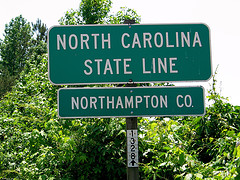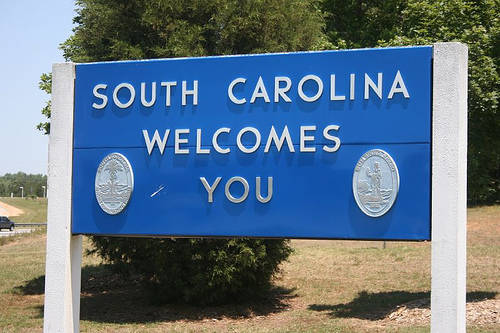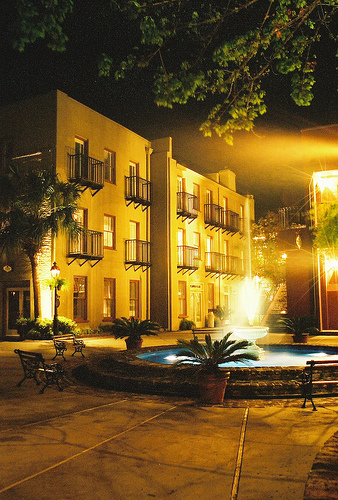Main Page > 2007 Havin' Fun on US 1
Waking in Richmond around 6:30, Mike and Bone grabbed coffee and bagels at a Panera Bread that Bone use to frequent where he ran into an old Capital One client. After a few exchanges of pleasantries the Boys headed through the City with hope to be through Richmond before Rush Hour. By 8:00 they were through the City and 13 miles south into the City of Petersburg where the Boys stopped to see the Petersburg Battlefield, especially the Infamous Crater !!!
Sieging Petersburg
The Siege of Petersburg was a series of battles around Petersburg, Virginia and was fought from June 15, 1864, to March 25, 1865. It was ten months of trench warfare in which Union forces commanded by Lt. Gen. Ulysses S. Grant assaulted Petersburg unsuccessfully and then constructed trench lines that eventually extended over 30 miles around the eastern and southern outskirts of the city.
Petersburg was crucial to the supply of Confederate Gen. Robert E. Lee's army and the Confederate capital of Richmond. Lee finally yielded to the overwhelming pressure and abandoned both cities in April 1865, leading to his retreat and surrender in the Appomattox Campaign.
The Siege of Petersburg foreshadowed the trench warfare that would be common in World War I, earning it a prominent position in military history.
Petersburg, a prosperous city of 18,000, was a supply center for the Confederate capital of Richmond, given its strategic location just south of the city, its site on the Appomattox River that provided navigable access to the James River, and its role as a major crossroads and junction for five railroads. The taking of Petersburg by Union forces would make it impossible for Robert E. Lee to continue defending Richmond. The battle for the city began shortly after the Union defeat at Cold Harbor. Grant decided to take Richmond through Petersburg, and he began positioning the Union army on June 15 by slipping away from Lee and crossing the James River. This represented a change of strategy from that of the preceding Overland Campaign. There, confronting and defeating Lee's army in the open was the primary goal; now, Grant selected a geographic and political target and knew that his superior resources could besiege Lee there, pin him down, and either starve him into submission or lure him out for a decisive battle.
Burnside's Blunder
During the siege of
Pleasants, a mining engineer from
Burnside, whose reputation had suffered from his 1862 defeat
at the Battle of Fredericksburg and his poor performance earlier that year at
the Battle of Spotsylvania Court House, gave Pleasants the go-ahead, hoping to
restore his reputation.
The Infamous Crater
Digging began in late June, but even Grant and Meade saw the operation as, "A mere way to keep the men occupied," and doubted it of any actual strategic value. They quickly lost interest and Pleasants soon found himself with few materials for his project, to the extent that his men had to forage for wood to support the structure. Work progressed steadily, however. Earth was removed by hand and packed into improvised sledges made from cracker boxes fitted with handles, and the floor, wall, and ceiling of the mine were shored up with timbers from an abandoned wood mill and even from tearing down an old bridge. The shaft was elevated as it moved toward the Confederate lines to make sure moisture did not clog up the mine, and fresh air was pumped in via an ingenious air-exchange mechanism near the entrance; the miners kept a fire continually burning at the bottom of a single ventilation shaft, which emerged behind the Union lines. Meanwhile, a wooden duct ran the entire length of the tunnel. The fire superheated stale air, forcing it up the ventilation shaft and out of the mine. The resulting vacuum then sucked fresh air in from the mine entrance, and carried it through the wooden duct to the location where the miners were working.
Venting their Anger?
This precluded the need for additional ventilation shafts and
served well in disguising the diggers' progress. On July 17, the main shaft
reached under the Confederate position. Rumors of a mine construction soon
reached the Confederates, but Lee refused to believe or act upon it for two
weeks before commencing countermining attempts, which were sluggish and
uncoordinated, and they were unable to discover the mine. General John Pegram,
whose batteries would be above the explosion, did, however, take the threat
seriously enough to build a new line of trenches and artillery points behind his
position as a precaution.
Getting the Shaft
Grant and Meade suddenly decided to use the mine three days after it was complete after a failed attack known later as the First Battle of Deep Bottom. The Federals filled the mine with 320 kegs of gunpowder, totaling 8,000 pounds. The explosives were approximately 20 feet underneath the Confederate works and the T gap was packed shut with 11 feet of earth in the side galleries and a further 32 feet of packed earth in the main gallery to prevent the explosion blasting out the mouth of the mine.
On July 28, the mine was armed.
Meade, who lacked confidence in the operation, ordered
Burnside not to use the black troops in the lead assault, thinking the attack
would fail and the black soldiers would be killed needlessly, creating political
repercussions in the North. Burnside protested to General Grant, who sided with
Meade. Burnside selected a replacement white division by having the commanders
draw lots. Brig. Gen. James H. Ledlie's 1st Division was selected, but he failed
to brief the men on what was expected of them and was reported during the battle
to be drunk, well behind the lines, providing no leadership. (Ledlie would be
dismissed for his actions during the battle.)
Ledlie's untrained white division went across the field to
the crater and, instead of moving around it, thought it would make an excellent
rifle pit and it would be well to take cover and so they moved down into the
crater itself, wasting valuable time while the Confederates, under Maj. Gen.
William Mahone, gathered as many troops together as they could for a
counterattack. In about an hour's time, they had formed up around the crater and
began firing rifles and artillery down into it, in what Mahone later described
as a "turkey shoot". The plan had failed, but Burnside, instead of cutting his
losses, sent in Ferrero's men. They also went down into the crater, and for the
next few hours, Mahone's soldiers, along with those of Maj. Gen. Bushrod
Johnson, and artillery slaughtered the IX Corps as it attempted to escape from
the crater. Some Union troops eventually advanced and flanked to the right
beyond the Crater to the earthworks and assaulted the Confederate lines, driving
the Confederates back for several hours in hand-to-hand combat. Mahone's
Confederates conducted a sweep out of a sunken gully area about 200 yards from
the right side of the Union advance. This charge reclaimed the earthworks and
drove the Union force back towards the east.
Completing their Tour of the Crater, the boys headed south on US-1 into the southern Virginia country-side, through quaint little towns such as Dinwiddie and South Hill, an finally passing into 9th state of Tour, North Carolina !!
"Carolina on My Mind"
In my mind I'm goin' to Carolina
Can't you see the sunshine
Can't you just feel the moonshine
Ain't it just like a friend of mine
To hit me from behind
Yes I'm goin' to Carolina in my mind
James Taylor

Driving into Carolina, didn't really change the scenery much for the Boys, it was simply mile after mile of country roads and little village in another unusually warm Fall day.
Good ole' fashion Carolina Barb-be-que !!!
Getting hungry Mike and Bone pulled off at one of those local bar-b-que joints you always hear about, with the signature vinegar-based, pulled pork and cole slaw, yummy !!! Grabbing their cheap lunches the Boys decided to take a break from driving and sat out side on some picnic tables under a Tree trying to hide from the unseasonable heat.
Trailer Trash Lunching: As Mike and Bone munched on their barb-que sandwiches , they amusedly observed the posturing and making out of a biker in his late 30's and a 17-18 year old girl at the net table. The Boys only hoped that they wouldn't breed and diminish the gene pool !!!!
Cruising through the South
After lunch Mike and Bone just rolled lazily through the hottest part of the day, well into the uncharacteristic 90 degree heat drowsily chatting about politics, religion, and family. As they rolled along they again noticed the effects of the severe drought that was effecting the entrie Easten seaboard, and hitting the South particularly hard.
Passing into the Palmetto State

Mile and Bone crossed the State Line around 4:00 and wanted to bee-lined it to Columbia as soon as possible, because Columbia is the State Capital, The home of the University of South Carolina Gamecocks, and most importantly, the home of Franks R
Franks a lot !!!
The sad story of Franks ! During the US-1 tour the Boys detoured in South Carolina to Columbia. in order to stop into Franks Restaurant, which was not only on the Hot Dog Program, but is listed in the National Historic Places. Getting directions on Google, Mike and Bone went to the right intersection in Columbia, alas no Franks !!
In its place is a Mexican motiffed, College Bar, asking in the Bar what happened to Franks, the waitress brought out a old hippie cook. The Cook actually worked for Frank back in the day, apparently one day in the lat 1990's Frank had a massive heart attack and almost died. They closed the restaurant while Frank recuperated . Frank got out of the Hospital on a Sunday, opened the next day Monday, and closed for good the next day, Tuesday. So sadly Mike and Bone will never experience the tubesteak culinary splendour of Franks.
US-1 Detour
At this point in the trip US-1 swings away from the Coast and traces close to the Georgia Border, with no interesting stops along the way and also misses two of the coolest cities in the South: Charleston and Savannah !! Not wanting to miss these gems, the Boys "detoured" down I-26 to Charelson, with plans to take US-17 from Charleston to Savannah, and link up with US-1 just North of Jacksonville Florida.
Charmin' Ole Charleston !!!

Mike and Bone invaded the historic confines of Charleston around 10:00 and headed immediately to the old town part of the city and f4ound a cool old Hotel that was willing to put them up for the night !
The History of Charles Town: !After Charles II of England (1630-1685) was restored to the British throne following Oliver Cromwell's Protectorate, he granted the chartered Carolina territory to eight of his loyal friends, known as the Lords Proprietor, in 1663. It took seven years before the Lords could arrange for settlement, the first being that of Charles Town. The community was established by English settlers in 1670 on the west bank of the Ashley River, a few miles northwest of the present city. It was soon chosen by Anthony Ashley-Cooper, one of the Lords Proprietor, to become a "great port towne", a destiny which the city fulfilled. By 1680, the settlement had grown, joined by others from England, Barbados, and Virginia, and relocated to its current peninsular location. The capital of the Carolina colony, Charleston was the center for further expansion and the southernmost point of English settlement during the late 1600s. The settlement was often subject to attack from sea and from land. Periodic assaults from Spain and France, who still contested England's claims to the region, were combined with resistance from Native Americans, as well as pirate raids. Charleston's colonists erected a fortification wall around the small settlement to aid in its defense. Two buildings remain from the Walled City, the Powder Magazine, where the city's supply of gunpowder was stored, and the Pink House, believed to have been an old colonial tavern.[8] A 1680 plan for the new settlement, the Grand Modell, laid out "the model of an exact regular town," and the future for the growing community. Land surrounding the intersection of Meeting and Broad Streets was set aside for a Civic Square. Over time it became known as the Four Corners of the Law, referring to the various arms of governmental and religious law presiding over the square and the growing city.
The dirty secret of the Market Square
Mike and Bone landed in the Historic Square Area which is now mostly gentrified and touristy, and where all the chi-chi bars and restaurants are gathered around the old Charleston Market Square. The Market Square is still used for weekend produce and flower sales. However the Market Square has a much more dark and dirty secret,, it was one of the oldest Slave Markets in Colonial America. Tens of thousands of Africans were peddled like farm animals through the Square. Today flesh is still peddled but at no cost (well and no direct cost !) as the Square as a high concentration of single bars filled with Southern hotties ! Since Mike and Bone were not able to indulge in slaw dogs at the afor-mentioned defunct Franks Restaurant they prowled the market for a cool dining spot.
Mistral ! Mistral !!
Mistral ! Mistral !! Just so happened to be one of those chi-chi restaurants in Market Square that is a fusion of fine French Cuisine and service with a South Carolina Low-Country flair. Mike ordered and thoroughly enjoyed blackened fresh fish, while Bone chowed on Bouillabaisse.
The Beginning of Margie Madness !!
To-date, the Bone had been fairly calm in their partying, but now the storm was unleashed. The made a pact to have one Margie in each of the many, many bars in the Market Square area. The quality of the margies and the crowd depended on the bars. The sports bars margies were surprisingly good, whereas the margies at the bars that catered to the younger crowds were chemically-tasting frozen crap. The Boys bopped between the bars until 1:30 AM when they finally called it a night and a very long day that had started in the Capital of the Confederacy and ended where the Civil War started. But more on that tomorrow morning !!!